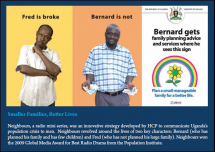Health Communication Partnership, Uganda
Funded by USAID, and running from 2004-2012, HCP was a global project managed by JHU CCP, to develop and implement communication strategies and strengthen capacity in social and behavior change communication (SBCC) for improved health in Uganda. Working in partnership with the Ugandan government and its partners, including USAID Implementing Partners, the project focused primarily on HIV prevention, care, treatment, and support; sexual and reproductive health of young people; family planning; malaria control; and TB control; while strengthening national SBCC capacity.
Camapigns under HCP included:
Young, Empowered, and Healthy (Y.E.A.H.)
Young Empowered And Healthy (Y.E.A.H) is an initiative of the Uganda AIDS Commission (UAC) designed in 2004 to address the growing need to improve health and social practices among young people inUganda. Y.E.A.H. exists as a response to the Uganda Government’s call for improved coordination and intensity of Behaviour Change Communication (BCC) efforts for young people 15-24 years of age and contributes to the National Strategic Plan for HIV prevention
True Manhood Campaign (part of Y.E.A.H.)
This campaign took on various issues
From 2009 to 2010, HIV prevention was repositioned as a masculine trait: “True manhood means doing what it takes to prevent HIV”.
From 2010-2012, the True Manhood Alcohol Campaign encouraged young men and women to drink responsibly or not at all.
From 2011 to 2012, the True Manhood Violence Against Women Campaign aimed to convince young men to treat their partners non-violently and to encourage other men to do the same
Rock Point 256
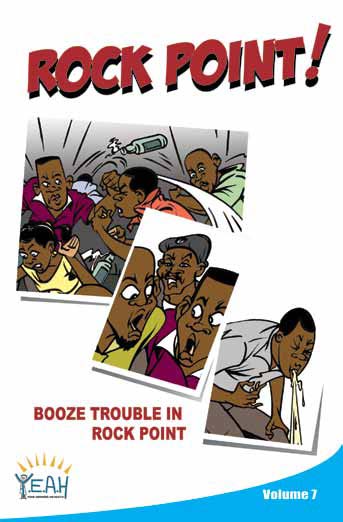
The centerpiece of the Y.E.A.H. initiative is the weekly radio drama and comic book series entitled “Rock Point 256″.The 30-minute radio serial drama was voted the best radio program of 2010 by readers of New Vision, the leading daily newspaper in Uganda. Rock Point 256 told the story of people who live in a fishing and farming community in Uganda. The radio serial was designed to influence the actions of its young listeners by modeling behavior change among the “transitional characters” who were similar to the program’s intended audiences. It sought to help young people choose attitudes and lifestyles that protect them from HIV, unplanned pregnancies and other social problems.
The National Health Hotline (part of Y.E.A.H.)
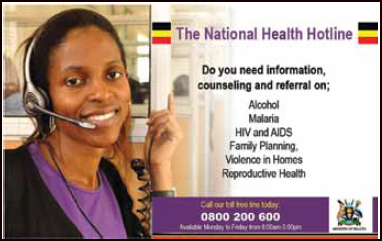
Also part of Y.E.A.H., between 2007 and 2008, HCP through the Y.E.A.H. initiative conducted a mapping exercise, which identified a dearth of youth-friendly services as well as a complete lack of specialized services to address alcohol and violence against women. People simply did not know where to go for needed services or whom they could get information from to make an informed health decision. This identified health information gap, coupled with evidence that by 2010 more than 10 million Ugandans would have access to mobile phones, sparked the idea of a free telephone counseling and referral service. The service would provide timely, accurate and reliable information to people about health issues and available services. In 2009, UAC and MOH, through Communication for Development Foundation Uganda (CDFU), with technical support from HCP took steps to establish a National Health Hotline to provide health information to callers from all parts of Uganda.
Fred and Bernard Campaign for Male Involvement
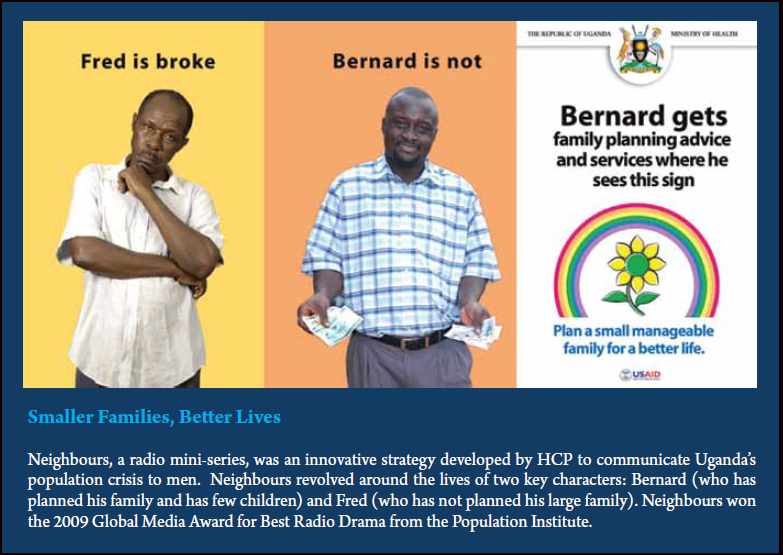 The first campaign, from 2006 – 2009, focused on increasing male involvement in family planning. The specific objective of the campaign was to increase the proportion of men who want to have smaller families and who discuss family planning with their partners. The campaign revolved around two characters: Fred,who had a large family and was struggling to provide for them; and Bernard, who had a small family and was able to provide for their needs. This Fred & Bernard Campaign was centred on a radio mini-drama series, Neighbours, which reached millions of Ugandans across the country. The campaign also used radio spots, television adverts, posters, and billboards to communicate the key message to men:“smaller families for a better life.”
The first campaign, from 2006 – 2009, focused on increasing male involvement in family planning. The specific objective of the campaign was to increase the proportion of men who want to have smaller families and who discuss family planning with their partners. The campaign revolved around two characters: Fred,who had a large family and was struggling to provide for them; and Bernard, who had a small family and was able to provide for their needs. This Fred & Bernard Campaign was centred on a radio mini-drama series, Neighbours, which reached millions of Ugandans across the country. The campaign also used radio spots, television adverts, posters, and billboards to communicate the key message to men:“smaller families for a better life.”
Nurse Mildred Campaign
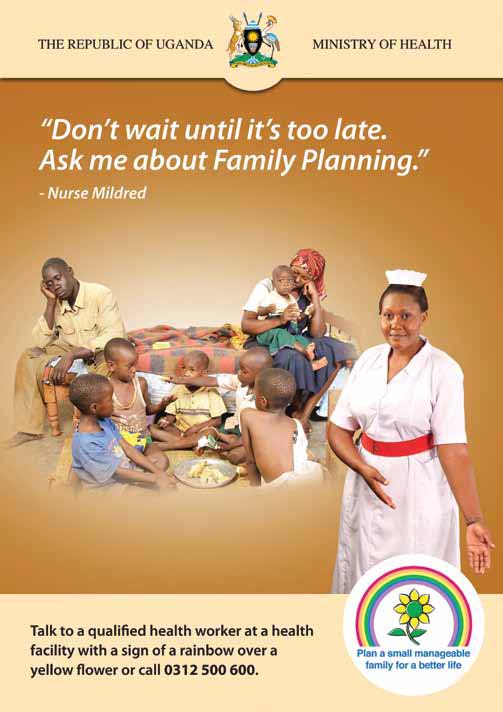 Nurse Mildred, ran from 2011 to 2012 and targeted rural and peri-urban women with unmet need for family planning and their partners, with the aim of convincing them of the safety and effectiveness of modern family planning methods.The campaign centered around a weekly radio drama and call-in talk show series broadcast in English and six local languages and run simultaneously in 16 radio stations across the country.
Nurse Mildred, ran from 2011 to 2012 and targeted rural and peri-urban women with unmet need for family planning and their partners, with the aim of convincing them of the safety and effectiveness of modern family planning methods.The campaign centered around a weekly radio drama and call-in talk show series broadcast in English and six local languages and run simultaneously in 16 radio stations across the country.
Go Together Know Together
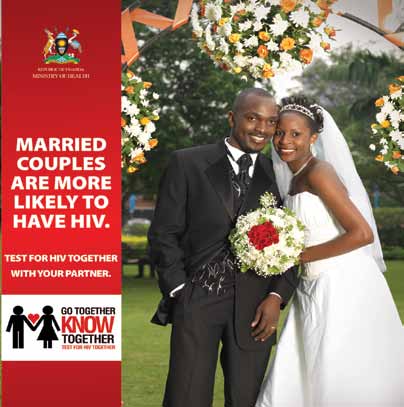 Go together Know together, promoted couples’ HIV counseling and testing by getting couples who did not know their HIV status to recognize their risk of HIV, and by building their belief that CHCT will benefit their relationships. The campaign also identified CHCT services with an attractive logo, and educated couples where to go for services. For couples who had tested
Go together Know together, promoted couples’ HIV counseling and testing by getting couples who did not know their HIV status to recognize their risk of HIV, and by building their belief that CHCT will benefit their relationships. The campaign also identified CHCT services with an attractive logo, and educated couples where to go for services. For couples who had tested
together, the campaign included specific messages for the three possible outcomes: both man and woman are HIV-negative; both man and woman are HIV-positive; or the couple is discordant.
Stand Proud Get Circumcised

In December, 2011, MOH launched the Stand Proud, Get Circumcised demand creation campaign, with the assistance of HCP and many other partners supporting the provision of SMC services. The campaign strategy is designed to convince men who already intend to circumcise to get safe male circumcision services, while encouraging women to support their men to
get circumcised and to adhere to post-circumcision practices that promote healing.
Source: Johns Hopkins Center for Communication Programs
Date of Publication: May 19, 2020
SIMILIAR RESOURCES
Tools
Examples
- Guide de Formation Conseil Dépistage du VIH au niveau Communautaire: manuel à l'intention du personnel non médical
- Reaching First-Time Parents and Young Married Women for Healthy Timing and Spacing of Pregnancies in Burkina Faso
- Making Content Meaningful: A Guide to Adapting Existing Global Health Content for Different Audiences
- Accelerator Behaviors
- The Behavior Change Framework
- The ECHO Study Report
- Hormonal Contraceptive Eligibility for Women at High Risk of HIV: Guidance Statement
- Integrated SBCC Programs: Key Challenges and Promising Strategies - Webinar
- HIV and Sexual and Reproductive Health Programming: Innovative Approaches to Integrated Service Delivery
- Voluntary Medical Male Circumcision In-Service Communication Best Practices Guide

